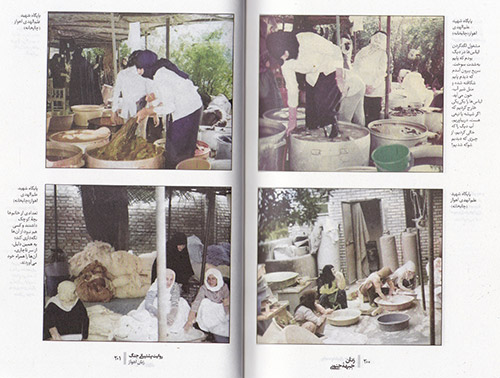Women of the South Front
Mahya Hafizi
Translated by: Zahra Hosseinian
2023-07-25
The book Women of the South Front is the narration of Ahvaz women's support for the war, published by the Oral History department of the Cultural Front Studies Office of the Islamic Revolution (Rahyar Publications). The book was researched by Maryam Moradi Kouhbad and edited by Narges Eskandari. In the title page, of course, the names of two other researchers, Zahra Gharacheh and Zeinab Babaei also can be seen. The book was published in 2023 in 1000 copies, having 216 pages and a price of Seven Thousand Tomans.
The cover designed with a khaki shirt pocket of the fighters, along with a button and a red thread spool with heart beat stitching. The cover looks like it is made of cloth, unless you hold the book in hand. The name of the book is on a sticky piece that is usually used in sewing. This book has tried to narrate a part of the struggle of girls and women behind the front. These narratives were compiled of 150 hours of interviews about the history of Ahvaz women. The research started in 2017 and ended in September 2020. The first stage of compiling the book started in December of the same year and ended 6 months later. Perhaps the memories of each of these women could not form a book alone, but collecting these short memories help the reader to understand the role of women in the war.
This book has 9 chapters and a total of 26 memories including color images and annexed documents. The title of the chapters are as follows: Removing dust and blood from the defense shirt, Patches, The offering packages, Salve for the wounds of war, Ahvaz of life, Support behind the benches, Motherly cooking, For the day when there are no men, and Hazrat Zainab's caravan.
The memories were categorized according to the title of each chapter. The name of the narrator has been written at the end of each memory. There are about 25 narrations, and some narrators have told several memories.
In her first memory, Zahra Shams has told: “There was no place to wash the soldiers' clothes. The smell of blood was scattered everywhere. There was a risk of falling into the water at the edge of the Shat River. Bibi Alamolhoda and Mr. Adelian took the teahouse, and brought detergents. With the onset of the war, even the old houses, where were sometimes the place of prayer and reciting the Quran, became the support unit of the front. There, anyone who heard the name of teahouse, went to help.
Sayedeh Narges Al-Imran, who was 13 years old at that time, learned how to wash the clothes and sheets in the same teahouse, and then took her friends for help. In the beginning, everyone went to the teahouse until Ms. Mowahed came from Tehran. She categorized the neighborhoods, and then specified a day for each neighborhood. Since many people had left Ahvaz and the city was empty, new forces were recruited in mosque every night after Maghrib prayer. About a hundred women were employed. They had ID card and attendance record book. Some clothes needed to be repaired. People brought some sewing machines. Sayedeh Narges Al-Imran said: "... I wished to do something; so, I started washing... I washed the clothes with laundry detergent powder, and if the stains still remained, I used soap. I was busy scrubbing a sheet when I felt a finger in my palm. I jumped up screaming. There was a lady next to me. She said there is no problem. it's normal. You get used to it. Later, I came to terms with it. It happened again, skin, hair, bones, etc., but now tears had replaced the fear."
The memories have continued with the social work in the hospital, the amputated limbs, and they have reached schools and hospitals. Through short memories have been narrated in this book, the difficult moments of supporting women in the war can be imagined. Sometimes, when they packed nuts and the like for the warriors, they put a little note on them such as ‘Well Done Warrior’, or other encouraging sentences. The motherly and sisterly love of these women had an effect on the spirit of the warriors, which can be perceived from memories. The color pictures of the book have explanations, and the current photos of most of the narrators, can be seen at the end of the book. If the social working of the women behind the front is searched online, a limited number of pictures can be found, but these pictures are different and diverse.

Number of Visits: 2355
http://oral-history.ir/?page=post&id=11342
